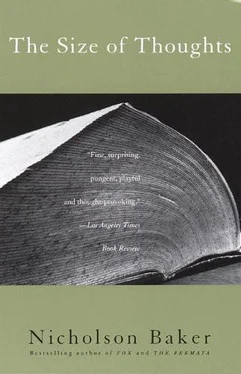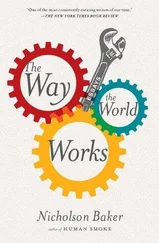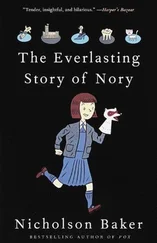Nicholson Baker - The Size of Thoughts - Essays and Other Lumber
Здесь есть возможность читать онлайн «Nicholson Baker - The Size of Thoughts - Essays and Other Lumber» весь текст электронной книги совершенно бесплатно (целиком полную версию без сокращений). В некоторых случаях можно слушать аудио, скачать через торрент в формате fb2 и присутствует краткое содержание. Год выпуска: 1997, Издательство: Vintage, Жанр: Публицистика, Критика, на английском языке. Описание произведения, (предисловие) а так же отзывы посетителей доступны на портале библиотеки ЛибКат.
- Название:The Size of Thoughts: Essays and Other Lumber
- Автор:
- Издательство:Vintage
- Жанр:
- Год:1997
- ISBN:нет данных
- Рейтинг книги:4 / 5. Голосов: 1
-
Избранное:Добавить в избранное
- Отзывы:
-
Ваша оценка:
- 80
- 1
- 2
- 3
- 4
- 5
The Size of Thoughts: Essays and Other Lumber: краткое содержание, описание и аннотация
Предлагаем к чтению аннотацию, описание, краткое содержание или предисловие (зависит от того, что написал сам автор книги «The Size of Thoughts: Essays and Other Lumber»). Если вы не нашли необходимую информацию о книге — напишите в комментариях, мы постараемся отыскать её.
The Size of Thoughts: Essays and Other Lumber — читать онлайн бесплатно полную книгу (весь текст) целиком
Ниже представлен текст книги, разбитый по страницам. Система сохранения места последней прочитанной страницы, позволяет с удобством читать онлайн бесплатно книгу «The Size of Thoughts: Essays and Other Lumber», без необходимости каждый раз заново искать на чём Вы остановились. Поставьте закладку, и сможете в любой момент перейти на страницу, на которой закончили чтение.
Интервал:
Закладка:
These lapses of realism probably have more to do with iconographic inertia than with any sort of conspiracy or coverup on the part of movie people. It isn’t that “they” don’t want us to know that the friendly century-old reel of celluloid, the reel that has fueled a million puns and that more than any other image means movies to us, has been superseded by a separate triple-tiered mechanism that, while full of visual interest, and quite beautiful in its indolent, wedding-cake-on-display sort of way, is less intuitively comprehensible than its predecessor. Hollywood producers don’t care whether we are aware that the platter system reduced the participatory role of the projectionist and helped make the multiplex theater financially attractive. (The eighteen-screen Cineplex Odeon in Los Angeles, for example, requires only two projectionists at any one time, and the twenty-six-screen complex in Brussels is comfortably tended by eight.) Nor do they care whether or not we know that platter hardware is, according to some critics, rougher on a movie print than reel-to-reel projection was.
“The platter is death to film,” Dr. Jan-Christopher Horak, the senior curator of films at the George Eastman House, in Rochester, told me. A print now must twist a hundred and eighty degrees on its axis as it completes the large open-air loop that leads from the feed platter through the projector to the takeup platter; this subjects it, Horak says, to a kind of helical stress that film stock has not previously had to withstand. He has been finding “strange stretch marks that aren’t vertical, as you might expect, but horizontal” on platter-fed films. And the platter system, he says, allows for unattended operation: if a hardy chunk of filth gets caught in the gate of the projector, it can scratch the film for hundreds of feet unremedied. Horak also mentions the lost-frame problem: every time a projectionist “builds” a feature on a platter, he must cut the leaders off each component reel and splice the ends in place; then, when the film is “broken down” at the end of its run, those splices are cut and the leaders reattached for shipping. In the process, each reel loses at least a frame of film. The more theaters a film visits, the shorter it gets.
Dick Twichell — a wise and careful projectionist at a twelve-screen Loew’s Theatre complex in greater Rochester, not far from Horak’s archival collection — admits that ambient dirt can cause serious trouble now. “Static electricity becomes more of a problem, because the film is out in the open air and attracts dust,” he says. The guide rollers, often made of plastic rather than metal, contribute to, rather than dissipate, static. And when a plex theater does something called “interlocking”—the simultaneous running of a single print through two or even three separate projectors, aimed at different screens — the film can travel hundreds of feet over guide rollers, paying out along the ceiling and returning low, inches from the floor, drawing dust along the way.
On the other hand, Twichell disagrees that the round trip to and from a platter physically overstresses a print. “If that were true, the splices would come apart, and they almost never do,” he says. In fact, Twichell, like many in the film industry, is of the opinion that platter hardware is far gentler on prints than reels were. A takeup reel had a primitive clutch: it pulled the film forcibly off the teeth of the projector’s lower sprocket, wearing out its perforations: a print would last perhaps three hundred runs, certainly no more than seven hundred, before becoming flimsy and easily torn. Now, on platters, a print can run almost indefinitely without sustaining that sort of mechanical damage. (There is a platter disaster known as a “brain-wrap,” but it is relatively rare.) Disney routinely gets ten or twenty thousand showings from a single print in its theme parks; often the dyes in the emulsion fade before the film succumbs.
Constant rewinding, which platters eliminate, was itself a major source of harm. “Fully nine-tenths of the damage to film comes from the process known as ‘pulling down’ in rewinding,” says the 1912 Motion Picture Handbook . The rainmarks, as they are called, that distance us from an old Buster Keaton picture, say, were probably made while it was being rewound, not while it was being cranked through the projector. Projectionists were traditionally tinkerers, techies, taciturn isolates with dirty fingernails; of necessity they worked (and still do work, some of them) surrounded by grease pots, oilcans, dirty rags, swapped-out components, and (before xenon bulbs came in, in the sixties) by the stubs of spent carbons from the carbon-arc lamps, each of which lasted no more than half an hour. Chuck McCann, who plausibly plays the hefty, chain-smoking hero of a 1970 film called The Projectionist (which is a sort of remake of the 1924 Buster Keaton movie Sherlock, Junior: the one about a projectionist who, dozing off on a stool by one of his machines, dreams that he has entered the film that he is showing), gets angry at Rodney Dangerfield (the manager) and slams a reel of film onto the rewinder, cranking hard and maintaining tension by resting his palm on the reel. The more brute film handling — rewinding, threading, splicing — that the typical projectionist was forced to do, the more beat-up the film became.
The Projectionist is filled with fun snippets from old movies, as is Cinema Paradiso (1989), a horribly sentimental Italian creation that is nonetheless accurate in portraying the local projectionist, rather than any director or studio head, as the person with the final cut. Cinema Paradiso ’s previewing priest rings a bell anytime people kiss onscreen, and the projectionist dutifully marks the moment in the reel with a strip of paper so that he can remove the kiss later. In truth, though, projectionists, at least in the United States, were more likely to be furtive editors and clip-collectors on their own (as the creators of The Projectionist seemingly were) than on behalf of local censors: they would simply cut out a few feet, or a frame or two, of an image or a sequence they liked. Commonly, they collected “favorite movie stars, and especially scenes or shots that had pieces of female anatomy in them,” Horak told me; the Eastman House now owns some of these collections. One projectionist told me that if you cut two frames from a scene where a camera is dollied sidewise, and you then view these frames through a stereoscope, you can simulate 3-D. After years in the projection business, this man has lost all interest in watching movies, and he has canceled HBO and Cinemax, but he continues to accumulate 3-D frames. He cuts them out, he hastened to say, only if they appear in a trailer, or at the front or back of a reel, where frames are meant to be lost anyway. Other projectionists may be less ethical. It could well be that hands-off platter automation helps projectionists resist the powerful temptation to keep souvenirs from the films that pass through their theaters.
Even with automation, though, there is a fair amount of under-the-hood maintenance connected with tending a projector. Early in The Inner Circle (1991), Tom Hulce, who plays Stalin’s projectionist, plucks something from his shirt pocket.
“What’s that you’re poking in the projector?” asks the alarmed K.G.B. official.
“Toothbrush,” Hulce says. “Very convenient for cleaning. I always carry one with me.” The K.G.B. man studies it, sniffs it. “The old projectionist never had anything like that,” he says, impressed.
Recently, after the last show of the night of The Remains of the Day , I watched Stephan Shelley, senior projectionist at the Grand Lake Theatre, in Oakland, California, clean the vitals of one of his eight projectors with a pale-blue Colgate toothbrush. (“A clean, used toothbrush is ideal,” advises the user’s manual for the current Century MSC-TA 35-mm. projector with self-turning lens turret.) Shelley greases the rods and gears of his Century projectors every morning; he uses rubbing alcohol and Q-Tips on the equipment daily as well; and he keeps a vigilant eye on the level of the oil bath in the all-important intermittent movement. (Seventy-millimeter film, he says, which has a magnetic rather than an optical soundtrack, leaves a projector especially dirty, because ferrous particles from the magnetic strip come off in the machine.) Fully cross-trained, he also fixes popcorn poppers when they break. There are occasional reports of projectionists less knowledgeable than Shelley who, having run out of projector oil, resort in desperation to pouring popcorn butter in the machines to keep them from freezing up. This practice voids the warranty, however.
Читать дальшеИнтервал:
Закладка:
Похожие книги на «The Size of Thoughts: Essays and Other Lumber»
Представляем Вашему вниманию похожие книги на «The Size of Thoughts: Essays and Other Lumber» списком для выбора. Мы отобрали схожую по названию и смыслу литературу в надежде предоставить читателям больше вариантов отыскать новые, интересные, ещё непрочитанные произведения.
Обсуждение, отзывы о книге «The Size of Thoughts: Essays and Other Lumber» и просто собственные мнения читателей. Оставьте ваши комментарии, напишите, что Вы думаете о произведении, его смысле или главных героях. Укажите что конкретно понравилось, а что нет, и почему Вы так считаете.












